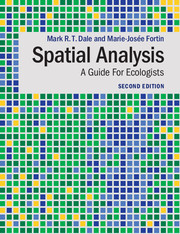Book contents
- Frontmatter
- Dedication
- Contents
- Preface
- 1 Spatial concepts and notions
- 2 Ecological and spatial processes
- 3 Points, lines and graphs
- 4 Spatial analysis of complete point location data
- 5 Contiguous units analysis
- 6 Spatial analysis of sample data
- 7 Spatial relationship and multiscale analysis
- 8 Spatial autocorrelation and inferential tests
- 9 Spatial partitioning: spatial clusters and boundary detection
- 10 Spatial diversity analysis
- 11 Spatio-temporal analysis
- 12 Closing comments and future directions
- References
- Index
6 - Spatial analysis of sample data
Published online by Cambridge University Press: 05 September 2014
- Frontmatter
- Dedication
- Contents
- Preface
- 1 Spatial concepts and notions
- 2 Ecological and spatial processes
- 3 Points, lines and graphs
- 4 Spatial analysis of complete point location data
- 5 Contiguous units analysis
- 6 Spatial analysis of sample data
- 7 Spatial relationship and multiscale analysis
- 8 Spatial autocorrelation and inferential tests
- 9 Spatial partitioning: spatial clusters and boundary detection
- 10 Spatial diversity analysis
- 11 Spatio-temporal analysis
- 12 Closing comments and future directions
- References
- Index
Summary
Introduction
Point pattern processes generate spatial distributions of point events, which can then be evaluated for their spatial structure using the methods presented in Chapter 4 (‘point pattern analysis’). The x–y coordinates of all events, whether individuals, objects, or categorized entities, in a given study area are required for this analysis. In ecological studies, a number of point pattern processes take place, a common one being seed or spore dispersal. Many ecological and environmental processes, however, generate spatially continuous data (e.g. soil moisture, temperature, etc.). The processes that generate such quantitative continuous variables are called surface pattern processes and the spatial statistics that analyse them ‘surface pattern’ methods or ‘area pattern’ methods.
There are grey zones, however, in the dichotomy between point pattern and surface pattern. Indeed, point data can be transformed into surface data by summing the number of events per sampling unit creating density values (see, for example, Gaucherel et al. 2007). Discrete qualitative point data can thus be converted into continuous quantitative data and so the spatial structure of point event data can be analysed using surface pattern methods. When the entire study area is surveyed by using contiguous sampling units, these quantitative data represent the entire population of data in the study area and can be analysed using the spatial methods for contiguous sample unit data presented in Chapter 5. As the sampling effort required to census an entire area is usually high, much of our understanding of natural complexity is based on sample data. The term ‘sample data’ refers to the fact that, within a study area, not all the area was studied explicitly, but only a subset of it. The aim of this chapter is to present a wide range of spatial statistics that explore, characterize, quantify, interpolate and test spatial patterns from sample data, which are, by their nature, incomplete. Although most surface pattern methods were developed to analyse sample data, they can of course be used with statistical ‘population data’ from a complete census.
- Type
- Chapter
- Information
- Spatial AnalysisA Guide For Ecologists, pp. 140 - 181Publisher: Cambridge University PressPrint publication year: 2014



